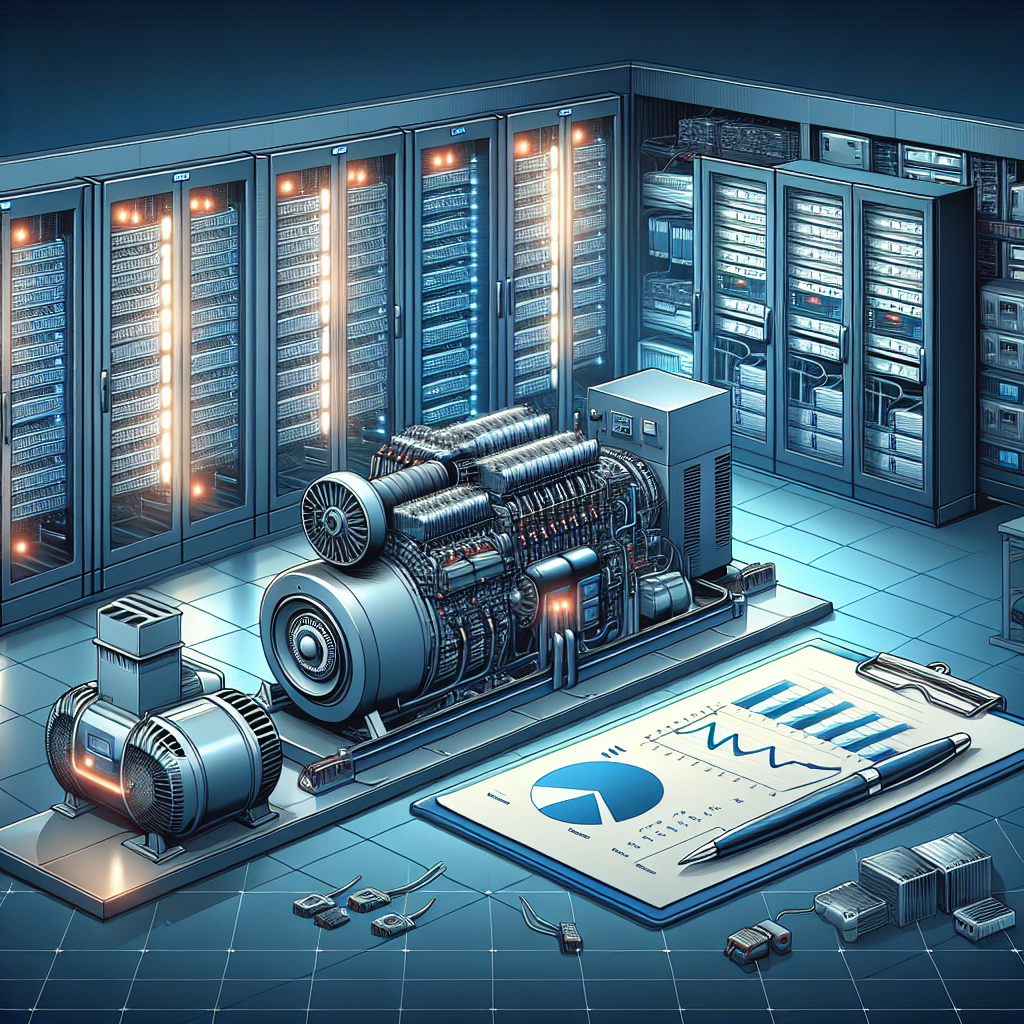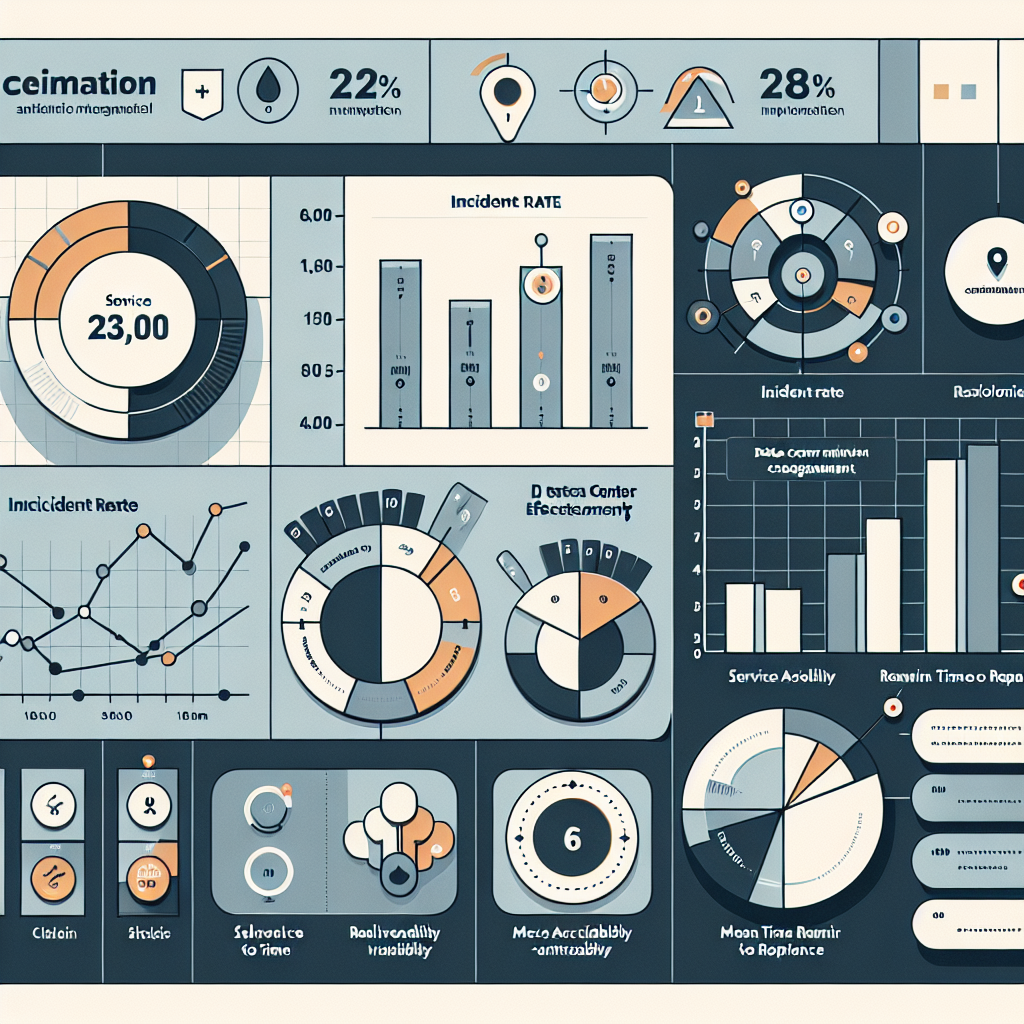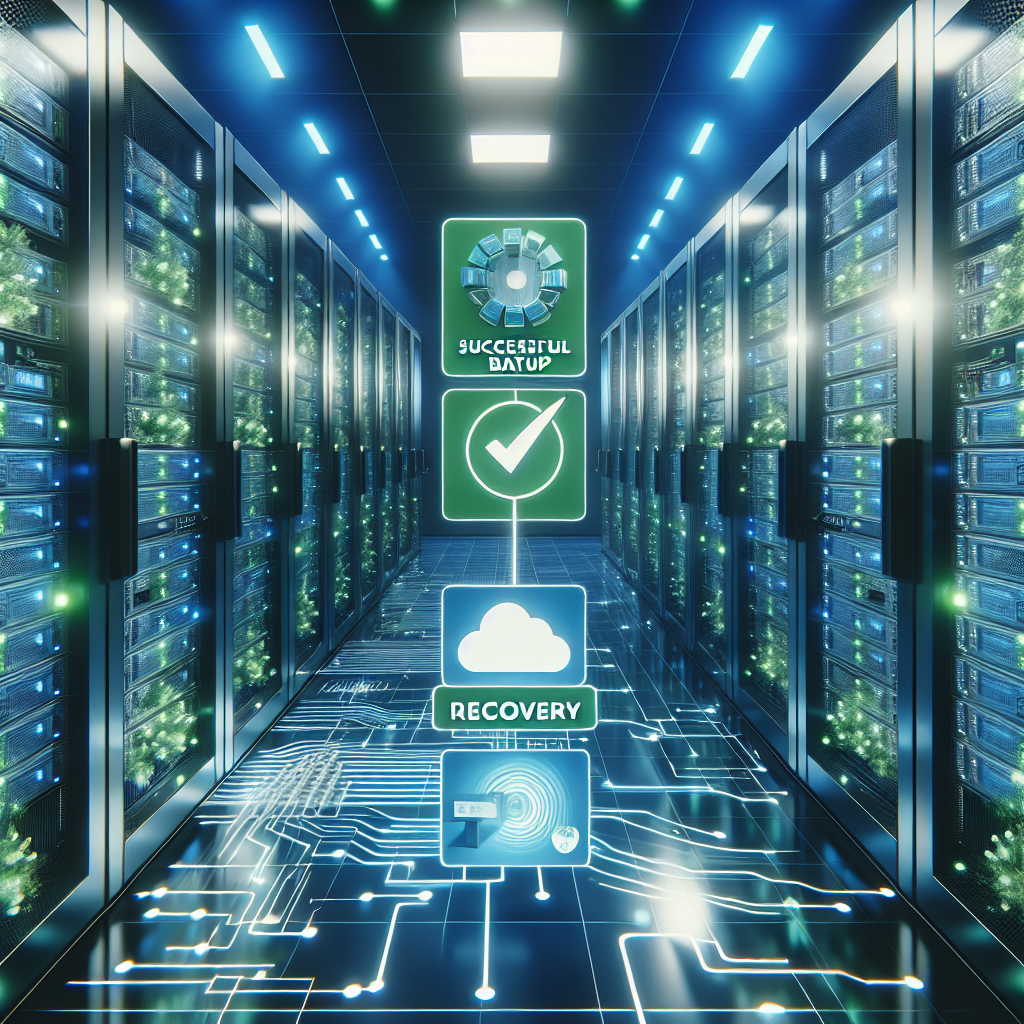Your cart is currently empty!
Tag: Effectiveness

Strategies for Streamlining Data Center Reactive Maintenance Processes for Efficiency and Effectiveness
In today’s fast-paced digital world, data centers play a crucial role in storing, processing, and managing vast amounts of information for organizations of all sizes. With the constant demand for uninterrupted access to data, it is essential for data center operators to have efficient and effective reactive maintenance processes in place to quickly address any issues that may arise.Reactive maintenance refers to the process of addressing unexpected problems or failures in the data center infrastructure after they occur. While proactive maintenance is important for preventing issues before they happen, reactive maintenance is equally critical for minimizing downtime and ensuring the smooth operation of the data center.
To streamline data center reactive maintenance processes for efficiency and effectiveness, data center operators can implement the following strategies:
1. Develop a comprehensive maintenance plan: A well-defined maintenance plan should outline the procedures, schedules, and responsibilities for reactive maintenance activities. This plan should include detailed checklists, escalation procedures, and documentation to ensure that all maintenance tasks are carried out efficiently and effectively.
2. Implement a ticketing system: Utilizing a ticketing system can help streamline the process of logging, prioritizing, and tracking maintenance requests. By centralizing all maintenance requests in one system, data center operators can easily assign tasks, monitor progress, and ensure that issues are resolved in a timely manner.
3. Prioritize maintenance tasks: Not all maintenance tasks are created equal, and it is essential to prioritize them based on their impact on the data center operations. By categorizing maintenance tasks according to their criticality and urgency, data center operators can focus their resources on addressing high-priority issues first to minimize downtime and maintain service levels.
4. Implement automation tools: Automation tools such as monitoring software, predictive analytics, and remote management capabilities can help data center operators proactively identify potential issues before they occur and streamline the reactive maintenance process. By automating routine tasks and alerts, operators can quickly respond to issues and resolve them before they escalate into larger problems.
5. Continuously improve processes: Data center operators should regularly review and evaluate their reactive maintenance processes to identify areas for improvement. By analyzing past maintenance events, collecting feedback from stakeholders, and implementing best practices, operators can refine their processes to enhance efficiency and effectiveness over time.
In conclusion, implementing strategies to streamline data center reactive maintenance processes is essential for ensuring the efficiency and effectiveness of data center operations. By developing a comprehensive maintenance plan, utilizing a ticketing system, prioritizing tasks, implementing automation tools, and continuously improving processes, data center operators can minimize downtime, maximize uptime, and provide a reliable and resilient infrastructure for their organization’s data needs.

Evaluating the Efficiency and Effectiveness of Data Center Generator Systems
Data center generator systems play a crucial role in ensuring uninterrupted power supply to critical IT equipment in the event of a power outage. These systems are designed to provide backup power to data centers, allowing them to continue operating seamlessly even during emergencies.However, it is important to regularly evaluate the efficiency and effectiveness of data center generator systems to ensure they are functioning optimally and can meet the demands of the data center. By assessing the performance of these systems, data center operators can identify any potential issues and address them before they impact the reliability and availability of the data center.
One of the key factors to consider when evaluating the efficiency of data center generator systems is their fuel consumption. Generators that consume excessive amounts of fuel can be costly to operate and may not be sustainable in the long run. By monitoring fuel consumption and comparing it to the power output of the generators, data center operators can determine if the systems are operating efficiently or if adjustments need to be made to improve their performance.
In addition to fuel consumption, the maintenance and upkeep of data center generator systems are also important aspects to consider when evaluating their effectiveness. Regular maintenance and inspections are essential to ensure that the systems are in good working condition and can perform as intended during a power outage. Data center operators should follow manufacturer recommendations for maintenance schedules and conduct regular tests to verify the functionality of the generators.
Furthermore, it is important to test the capacity of data center generator systems to ensure they can handle the load of the data center in the event of a power outage. Load testing can help determine if the generators are capable of providing sufficient power to critical IT equipment and if they can sustain the load for an extended period of time. By conducting load tests regularly, data center operators can identify any potential issues with the systems and address them before they become a problem.
Overall, evaluating the efficiency and effectiveness of data center generator systems is essential for ensuring the reliability and availability of data centers. By monitoring fuel consumption, conducting regular maintenance, and performing load tests, data center operators can identify any issues with the systems and take proactive measures to address them. Ultimately, a well-maintained and efficient generator system is crucial for ensuring uninterrupted power supply to critical IT equipment in data centers.

Key Metrics for Evaluating Data Center Incident Management Effectiveness
Data centers are the heart of modern businesses, housing critical IT infrastructure and sensitive data. With the increasing frequency and complexity of cyber threats, it is crucial for organizations to have an effective incident management strategy in place to quickly detect, respond to, and resolve any security incidents that may arise. Key metrics can help organizations evaluate the effectiveness of their data center incident management practices and identify areas for improvement.One key metric for evaluating data center incident management effectiveness is Mean Time to Detect (MTTD). MTTD measures the average time it takes for an organization to detect a security incident once it has occurred. A low MTTD indicates that an organization has effective monitoring and detection tools in place, enabling them to quickly identify and respond to security incidents before they escalate.
Another important metric is Mean Time to Respond (MTTR), which measures the average time it takes for an organization to respond to and resolve a security incident once it has been detected. A low MTTR indicates that an organization has efficient incident response processes in place, enabling them to quickly contain and mitigate the impact of security incidents on their data center operations.
The number of security incidents detected and resolved within a given time period is also a key metric for evaluating incident management effectiveness. By tracking the number of incidents and their severity levels, organizations can identify trends and patterns that may indicate weaknesses in their data center security posture and incident response capabilities.
Customer satisfaction and feedback are also important metrics for evaluating data center incident management effectiveness. By soliciting feedback from customers and stakeholders on their experiences with incident response processes, organizations can identify areas for improvement and ensure that their incident management practices meet the needs and expectations of their users.
In addition to these key metrics, organizations should also consider the effectiveness of their incident management training and awareness programs, as well as the availability and performance of their incident response tools and technologies. By regularly evaluating and monitoring these metrics, organizations can ensure that their data center incident management practices are robust, efficient, and effective in protecting their critical IT infrastructure and data assets.
In conclusion, evaluating key metrics for data center incident management effectiveness is essential for organizations to identify areas for improvement and ensure that their incident response practices are proactive, efficient, and responsive to emerging security threats. By monitoring and tracking these metrics, organizations can continuously optimize their incident management processes and enhance their overall security posture in an increasingly complex and dynamic threat landscape.

Key Metrics for Monitoring Data Center Incident Management Effectiveness
Data centers are critical components of modern businesses, housing servers, networking equipment, and storage systems that support the organization’s operations. As such, it is imperative for data center managers to have a robust incident management strategy in place to effectively address any issues that may arise.Monitoring the effectiveness of data center incident management is crucial for ensuring the smooth and uninterrupted operation of the facility. By tracking key metrics, data center managers can identify areas for improvement and make informed decisions to enhance the incident response process.
One key metric for monitoring data center incident management effectiveness is Mean Time to Repair (MTTR). MTTR measures the average time it takes to resolve an incident from the moment it is detected. A low MTTR indicates that the incident management process is efficient and effective, while a high MTTR may signal inefficiencies that need to be addressed.
Another important metric is the number of incidents reported within a specific time period. By tracking the frequency of incidents, data center managers can identify trends and patterns that may indicate underlying issues that need to be addressed. A sudden spike in incidents may indicate a systemic problem that requires immediate attention.
Furthermore, tracking the resolution rate of incidents can provide valuable insights into the effectiveness of the incident management process. A high resolution rate indicates that incidents are being addressed promptly and effectively, while a low resolution rate may indicate gaps in the incident response process that need to be addressed.
In addition to these metrics, data center managers should also track the root cause of incidents to identify recurring issues that may require a more permanent solution. By addressing the root cause of incidents, data center managers can prevent future occurrences and improve the overall reliability of the data center.
Overall, monitoring key metrics for data center incident management effectiveness is essential for ensuring the smooth and uninterrupted operation of the facility. By tracking metrics such as MTTR, incident frequency, resolution rate, and root cause analysis, data center managers can identify areas for improvement and make informed decisions to enhance the incident response process.

Measuring the Effectiveness of Root Cause Analysis in Data Center Operations
Root cause analysis (RCA) is a critical process in data center operations that helps identify the underlying reasons for problems or incidents. By understanding the root cause of issues, organizations can take proactive steps to prevent them from occurring in the future, ultimately improving overall efficiency and performance.Measuring the effectiveness of root cause analysis in data center operations is essential to ensure that the process is delivering the desired results. There are several key metrics that can be used to gauge the effectiveness of RCA, including:
1. Time to Resolution: One of the most important metrics in measuring the effectiveness of root cause analysis is the time it takes to identify and resolve the root cause of an issue. A shorter time to resolution indicates that the RCA process is efficient and effective in quickly pinpointing the underlying problem.
2. Incident Recurrence Rate: Another crucial metric to consider is the incident recurrence rate. If the same issues continue to occur repeatedly, it may indicate that the root cause analysis process is not effectively identifying and addressing the underlying problems.
3. Reduction in Downtime: The goal of root cause analysis is to minimize downtime and ensure the smooth operation of data center operations. Measuring the reduction in downtime before and after implementing RCA can help determine its effectiveness in preventing future issues.
4. Cost Savings: Root cause analysis can also lead to cost savings by preventing costly downtime, equipment failures, and other issues. Measuring the financial impact of RCA in terms of reduced costs can help determine its effectiveness.
5. Employee Satisfaction: Finally, employee satisfaction is an important metric to consider when measuring the effectiveness of root cause analysis. If employees feel that the RCA process is helping to address issues in a timely and efficient manner, it can lead to a more positive work environment and improved overall performance.
In conclusion, measuring the effectiveness of root cause analysis in data center operations is crucial for ensuring that the process is delivering the desired results. By tracking metrics such as time to resolution, incident recurrence rate, reduction in downtime, cost savings, and employee satisfaction, organizations can gain valuable insights into the impact of RCA on their operations. By continuously evaluating and optimizing the RCA process, organizations can improve efficiency, reduce costs, and enhance overall performance in their data center operations.

Measuring Data Center Performance and Effectiveness Through Audits
Data centers are the backbone of modern businesses, housing critical infrastructure and applications that keep organizations running smoothly. As such, it is essential to ensure that data centers are performing at their best and operating effectively. One way to measure data center performance and effectiveness is through audits.Audits are a systematic review of a data center’s operations, infrastructure, and processes to assess their performance and effectiveness. By conducting regular audits, organizations can identify areas for improvement, address potential issues, and ensure that their data center is running efficiently.
There are several key metrics that can be measured during a data center audit to evaluate its performance and effectiveness. These include:
1. Energy efficiency: Energy consumption is a significant cost for data centers, so measuring energy efficiency is crucial. Auditors can assess the data center’s Power Usage Effectiveness (PUE) ratio, which compares the total energy consumed by the data center to the energy consumed by the IT equipment. A low PUE ratio indicates better energy efficiency.
2. Cooling efficiency: Cooling systems are essential to maintaining optimal temperatures in a data center. Auditors can evaluate the effectiveness of cooling systems by measuring temperature differentials, airflow patterns, and humidity levels. Improving cooling efficiency can help reduce energy costs and prevent equipment overheating.
3. Security and compliance: Data centers store sensitive information and must comply with industry regulations and standards. Auditors can assess the data center’s security measures, such as access controls, surveillance systems, and disaster recovery plans, to ensure that data is protected and compliance requirements are met.
4. Capacity planning: Data centers must have enough capacity to meet current and future demands. Auditors can evaluate the data center’s capacity utilization, growth projections, and scalability to ensure that it can accommodate increasing workloads and technologies.
5. Maintenance and uptime: Regular maintenance is essential to prevent downtime and ensure the smooth operation of a data center. Auditors can review maintenance logs, service agreements, and uptime records to assess the data center’s reliability and availability.
By conducting regular audits and measuring key performance metrics, organizations can identify areas for improvement and optimize their data center’s performance and effectiveness. Audits provide valuable insights into the data center’s operations, helping organizations make informed decisions and ensure that their critical infrastructure is running at its best.

AI for Educators Made Easy: Unlock the Power of Artificial Intelligence to Enhance Teaching Effectiveness, Boost Student Engagement, and Embrace Ethical Practices
Price: $9.99
(as of Dec 16,2024 03:40:44 UTC – Details)From the Publisher




Why You’ll Love “AI for Educators Made Easy:”


ENGAGE EVERY STUDENT:
Use AI to personalize lessons and captivate your classroom.


SAVE VALUABLE TIME
Automate tasks like grading and planning to focus on teaching.


STAY ETHICAL
Adopt AI responsibly, protecting privacy and maintaining trust.


EASY FOR EVERYONE
Perfect for all educators, no matter your tech experience!


ASIN : B0DM2NFQKR
Publication date : November 4, 2024
Language : English
File size : 1300 KB
Simultaneous device usage : Unlimited
Text-to-Speech : Enabled
Screen Reader : Supported
Enhanced typesetting : Enabled
X-Ray : Not Enabled
Word Wise : Enabled
Print length : 153 pagesCustomers say
Customers find the book helpful and accessible. It provides a clear introduction to AI for educators and novices alike, offering practical tips and ethical practices. The writing quality is described as excellent and well-written.
AI-generated from the text of customer reviews
In today’s rapidly evolving digital world, educators are constantly seeking innovative ways to enhance their teaching effectiveness and boost student engagement. Artificial Intelligence (AI) is revolutionizing the way we approach education, providing educators with powerful tools to personalize learning, analyze student data, and streamline administrative tasks.AI for Educators Made Easy is a comprehensive guide that will help educators unlock the full potential of AI in the classroom. From understanding the basics of AI to implementing AI-driven teaching strategies, this book provides practical tips and strategies to help educators harness the power of AI to improve student outcomes.
With AI for Educators Made Easy, educators can take their teaching to the next level by:
– Personalizing learning experiences: AI tools can analyze student data to create personalized learning paths tailored to each student’s individual needs and learning styles.
– Boosting student engagement: AI-powered tools can create interactive and engaging learning experiences that keep students motivated and on track.
– Streamlining administrative tasks: AI can automate time-consuming administrative tasks, freeing up educators to focus on teaching and mentoring students.
– Embracing ethical practices: The book also addresses important ethical considerations related to AI in education, helping educators navigate potential challenges and ensure fair and unbiased use of AI tools.Whether you’re a seasoned educator looking to incorporate AI into your teaching practice or a new teacher curious about the potential of AI in education, AI for Educators Made Easy is your go-to resource for harnessing the power of AI to enhance teaching effectiveness, boost student engagement, and embrace ethical practices in the classroom.
#Educators #Easy #Unlock #Power #Artificial #Intelligence #Enhance #Teaching #Effectiveness #Boost #Student #Engagement #Embrace #Ethical #Practices
Streamlining Data Center Documentation for Efficiency and Effectiveness
In today’s fast-paced digital world, data centers play a crucial role in the operations of businesses of all sizes. These facilities house the servers, storage devices, networking equipment, and other hardware necessary to store and manage vast amounts of data. With the increasing complexity of data center environments, it has become more important than ever to have accurate and up-to-date documentation to ensure smooth operations and efficient troubleshooting.Streamlining data center documentation is essential for maximizing efficiency and effectiveness. By having a comprehensive and easily accessible repository of information about the data center’s infrastructure, administrators can quickly identify and address issues, plan for upgrades or expansions, and ensure compliance with regulatory requirements.
One of the key benefits of streamlining data center documentation is improved efficiency. When all relevant information about the data center’s equipment, configurations, and procedures is well-documented and organized, administrators can quickly locate the information they need without wasting time searching through multiple sources. This saves time and reduces the risk of errors, leading to faster problem resolution and improved overall productivity.
Effective data center documentation also enhances the ability to plan for future growth and changes. By documenting current configurations and capacities, administrators can easily identify opportunities for optimization and expansion. This information can be used to develop comprehensive upgrade plans, ensure that new equipment is compatible with existing infrastructure, and anticipate potential challenges before they arise.
Moreover, having accurate and up-to-date documentation is essential for maintaining security and compliance. Data centers are subject to a variety of regulations and standards, such as PCI DSS, HIPAA, and GDPR, that require strict controls over access to sensitive data and measures to protect against breaches. Comprehensive documentation of security controls, access policies, and audit trails is essential for demonstrating compliance with these requirements and ensuring that data remains secure.
To streamline data center documentation for efficiency and effectiveness, organizations should consider implementing the following best practices:
1. Establish a standardized documentation framework: Develop a consistent format and structure for documenting information about the data center’s infrastructure, including equipment inventories, network diagrams, configuration settings, and operational procedures. This will make it easier to locate and interpret information quickly and accurately.
2. Implement a centralized documentation repository: Use a dedicated system or platform to store and manage all documentation related to the data center. This will ensure that information is easily accessible to authorized personnel, can be updated in real-time, and is protected from loss or unauthorized access.
3. Regularly review and update documentation: Data center environments are constantly evolving, with new equipment being added, configurations changing, and procedures being updated. Regularly review and update documentation to ensure that it remains accurate and reflects the current state of the data center.
4. Train staff on documentation procedures: Provide training and guidance to data center staff on the importance of documentation, how to create and update documentation effectively, and how to access and use documentation when needed. This will help ensure that everyone understands the value of documentation and how to use it to support their work.
In conclusion, streamlining data center documentation is essential for maximizing efficiency, effectiveness, and security. By establishing standardized documentation frameworks, implementing centralized repositories, regularly reviewing and updating documentation, and training staff on documentation procedures, organizations can ensure that their data centers operate smoothly, securely, and in compliance with regulatory requirements. Investing in effective documentation practices is a wise investment that will pay off in improved operations, reduced downtime, and enhanced security and compliance.

Maximizing Efficiency and Effectiveness in Data Center Backup and Recovery Processes
In today’s digital age, data is at the core of every business operation. With the increasing amount of data being generated and stored, the need for efficient and effective data center backup and recovery processes has become more crucial than ever. Data loss can have severe consequences for any organization, including financial loss, reputational damage, and regulatory penalties. Therefore, it is essential for companies to implement robust backup and recovery strategies to protect their data and ensure business continuity.One of the key factors in maximizing efficiency and effectiveness in data center backup and recovery processes is having a comprehensive and well-thought-out backup strategy. This involves identifying critical data and determining the appropriate backup frequency, retention period, and storage location. By categorizing data based on its importance and sensitivity, organizations can prioritize their backup efforts and allocate resources accordingly.
Another important aspect of efficient data center backup and recovery processes is the use of automation and advanced technologies. Automation can streamline backup and recovery tasks, reducing the risk of human error and ensuring consistency in data protection practices. Additionally, technologies such as deduplication, compression, and encryption can help optimize storage space, accelerate data transfer speeds, and enhance data security.
Furthermore, regular testing and monitoring of backup systems are essential to ensure their reliability and effectiveness. Organizations should conduct routine backup tests to verify the integrity of their data and validate the recovery process. Monitoring tools can also provide real-time insights into backup performance, allowing administrators to identify and address any issues promptly.
In addition to technical considerations, it is crucial for organizations to have a well-defined data recovery plan in place. This plan should outline the steps to be taken in the event of data loss, including the roles and responsibilities of key personnel, the communication protocol, and the recovery timeline. By having a clear and actionable recovery plan, organizations can minimize downtime and mitigate the impact of data loss on their operations.
Overall, maximizing efficiency and effectiveness in data center backup and recovery processes requires a combination of strategic planning, technological innovation, and proactive management. By implementing a comprehensive backup strategy, leveraging automation and advanced technologies, and maintaining a robust recovery plan, organizations can protect their data assets and ensure business continuity in the face of unforeseen events. Investing in data protection measures is not only a prudent business decision but also a critical step towards safeguarding the future success of the organization.

Efficiency and Effectiveness: How Data Centers Enable Big Data Analytics and Machine Learning
In today’s digital age, the amount of data being generated and collected is growing at an unprecedented rate. From social media interactions to online transactions, the sheer volume of information being produced on a daily basis is staggering. As a result, businesses and organizations are turning to big data analytics and machine learning to make sense of this data and gain valuable insights that can drive decision-making and improve operations.One of the key components that enable big data analytics and machine learning is data centers. These facilities house the servers and storage systems that store and process vast amounts of data in a secure and reliable environment. Data centers play a crucial role in ensuring the efficiency and effectiveness of these data-driven technologies.
Efficiency is essential in data centers because they consume a significant amount of energy to power and cool the servers and equipment. By optimizing the design and layout of the data center, businesses can minimize energy consumption and reduce operating costs. This can be achieved through the use of energy-efficient cooling systems, server virtualization, and other technologies that help to maximize the use of resources.
In addition to efficiency, data centers also need to be effective in order to support the demands of big data analytics and machine learning. This means having the necessary infrastructure in place to handle large volumes of data, as well as the computing power and processing capabilities to run complex algorithms and models. Data centers must also be able to scale up or down quickly to accommodate changing data needs and workloads.
Moreover, data centers play a critical role in data security and compliance. With the increasing focus on data privacy and protection, businesses need to ensure that their data is stored and processed in a secure environment. Data centers are equipped with advanced security measures, such as firewalls, encryption, and access controls, to safeguard sensitive information and prevent unauthorized access.
Overall, data centers are essential for enabling big data analytics and machine learning to operate efficiently and effectively. By investing in modern, well-designed data centers, businesses can harness the power of data to drive innovation, improve decision-making, and gain a competitive edge in today’s data-driven economy. As the amount of data continues to grow, the role of data centers will only become more crucial in supporting the evolving needs of businesses and organizations.

